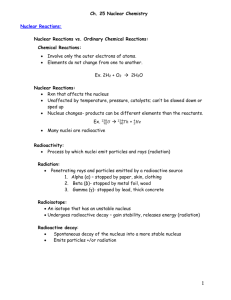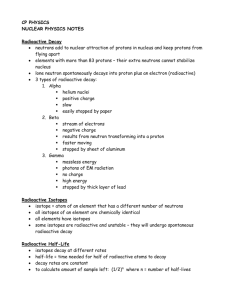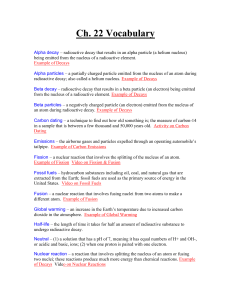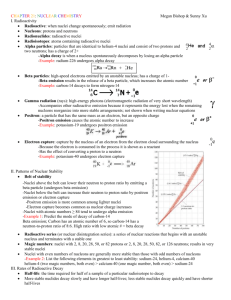Notes- Ch 25
advertisement
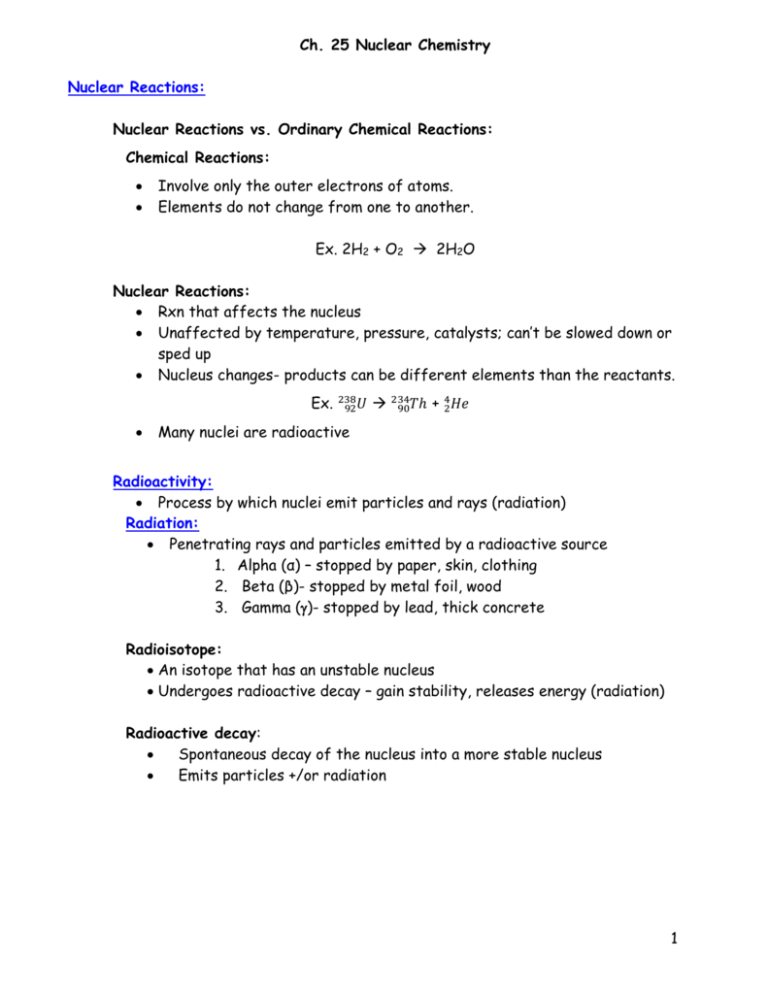
Ch. 25 Nuclear Chemistry Nuclear Reactions: Nuclear Reactions vs. Ordinary Chemical Reactions: Chemical Reactions: Involve only the outer electrons of atoms. Elements do not change from one to another. Ex. 2H2 + O2 2H2O Nuclear Reactions: Rxn that affects the nucleus Unaffected by temperature, pressure, catalysts; can’t be slowed down or sped up Nucleus changes- products can be different elements than the reactants. Ex. 238 92𝑈 234 90𝑇ℎ + 42𝐻𝑒 Many nuclei are radioactive Radioactivity: Process by which nuclei emit particles and rays (radiation) Radiation: Penetrating rays and particles emitted by a radioactive source 1. Alpha (α) – stopped by paper, skin, clothing 2. Beta (β)- stopped by metal foil, wood 3. Gamma ()- stopped by lead, thick concrete Radioisotope: An isotope that has an unstable nucleus Undergoes radioactive decay – gain stability, releases energy (radiation) Radioactive decay: Spontaneous decay of the nucleus into a more stable nucleus Emits particles +/or radiation 1 Types of Radioactive Decay (Transmutation): Sum Reactant’s Atomic # and mass # = Sum Product’s atomic # and mass # Ex. 49𝐵𝑒 + 42𝐻𝑒 12 6𝐶 + 10𝑛 Atomic # changes = identity of element changes 1. Alpha Emission (α): Too many neutrons and protons- gets rid of 2 of each An alpha particle ( 238 U 92 ) is emitted. 234 4 Th + He 90 2 2. Beta Emission (β): Too many neutrons – neutron converted into a proton and electron A beta particle β (electron) ( −10𝑒) is emitted 14 C 6 14 0 N+ e 7 -1 3. Gamma Emission (): Emission of electromagnetic energy No particles are emitted during gamma radiation 4. Positron Emission (β): Too many protons – protons converted into a neutron A positron ( 0 +1 5. Electron Capture: e) is emitted 38 K 19 38 0 Ar + e 18 +1 Too many protons, converts a proton to a neutron by capturing an electron ( 0 -1 e) 0 106 Ag + -1 47 106 Pd 46 2 Artificial Transmutation: Particles bombard the nucleus of an atom Particle accelerator (Atom Smasher), Nuclear reactors, Nuclear bombs Elements above 92 = man-made ex. 14 4 17 1 7N + 2He 8O + 1H 238 92U + 10n 239 92U 239 93Np + 0 −1e Higgs-boson (crazy girl) Higgs-boson Ted ED cartoon* More Higgs-boson explanation http://ed.ted.com/lessons/brian-cox-on-cern-s-supercollider* Half-Life: Time it takes for ½ of the atoms of a radioactive isotope to decay More stable isotopes – decay slowly longer ½ life Less stable isotopes- decay quickly shorter ½ life 3 Calculating Half-Life: Ex. 1 Radioactive element has a ½ life of 30 days of an 8 gram sample, how much will be unchanged after 90 days? After: ½life Time Unchanged (Parent) Changed (daughter) 0 0 8 grams (0grams) st 1 30 days 4 grams (4 grams) nd 2 60 days 2 grams (6 grams) rd 3 90 days 1 gram (7 grams) Ex. 2 The ½ life of radium-224 is 3.66 days. What was the original mass of radium-224 if 0.0500 grams remain after 7.32 days? Amount remaining= (initial amount)(1/2) n n= t/T t=time elapsed T=length of ½ life n= # of ½ lives soo…. n=7.32/3.66 n= 2 0.0500g=X(1/2)2 = 0.0500=x(.25) .25 .25 X= .2 grams Ex.3 The following is know about a fossil bone: a.) Amount of carbon-14 originally in bone = 800g b.) Amount of carbon-14 presently in bone = 100g c.) Amount of nitrogen-14 presently in bone = 700g d.) half-life = 5,730 yrs How old is the fossil bone? 17,190 yrs ½ life Time 0 0 yrs 1st 2nd 3rd 5,730 yrs 11,460 yrs 17,190 yrs P (C-14) D (N-14) 800g 0g 400g 200g 100 g 400g 600g 700g 4 Comparing Fission & Fusion: Fission: Heavy nuclei are split into lighter nuclei. Relatively easy to control but produce radioactive wastes. Plutonium and uranium Fission Three mile Island Chernobyl I Chernobyl II Fukushima I Fukushima TIME explanation Fusion: Light nuclei are combined to form heavier nuclei. Difficult to initiate and control but produce little radioactive wastes. 5 6
